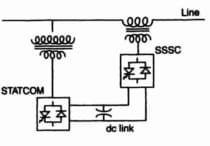 |
| Basic Electrical |
Inductance and Capacitors
1. Their inductances, 1 H, 2 H and L H are in parallel. The maximum value
of equivalent inductance will be_____.
a. 3 H
b. 0 H
c. 3/2 H
d. None of these
2. Assertion(A) : In steady state condition, the energy consumed is
infinite for both inductor and capacitor.
Reason(R) : The current i in the capacitor and voltage v in the inductor
are zero in steady state.
a. A is false but R is true
b. A is true but R is false
c. Both A and R true but R is not the correct explanation of A
d. Both A and R true ans R is the correct explanation of A
3. Assertion(A) : If the voltage across the capacitor being constant,
current through it is zero.
Reason(R) : On application of dc voltage and with no initial charge, the
capacitor first acts as short circuit but as soon as the full charge it
retains, the capacitor behaves as open circuit.
a. A is false but R is true
b. A is true but R is false
c. Both A and R true but R is not the correct explanation of A
d. Both A and R true ans R is the
correct explanation of A
4. A 100 turn coil has an inductance of 6 mH. If the number of turns is
increased by 200%, all other quantities remaining the same, the inductance will
be_______.
a. 3 mH
b. 12 mH
c. 24 mH
d. None of these
5. Which of the following statements associated with capacitor is wrong?
a. A finite amount of energy can be stored in a capacitor even if the
current through the capacitor is zero, such as when the voltage across it is
constant.
b. It is impossible to change the voltage across a capacitor even if the
current through the capacitor changes by a finite amount in zero time, for this
requires infinite current through the capacitor.
c. A capacitor resists an abrupt
change in the current flowing through it.
d. A capacitor resists an abrupt change in the voltage across it in a
manner analogus to the way a spring resists abrupt change in its displacement.
6. Assertion(A) : Lower the self
inductance of a coil more the delay in establishing steady current through it.
Reason(R): An inductor opposes a sudden change in current
a. A is false but R is true
b. A is true but R is false
c. Both A and R true but R is not the correct explanation of A
d. Both A and R true ans R is the correct explanation of A
7. An open coil has______.
a. Zero resistance and infinite inductance
b. Infinite resistance and zero
inductance
c. Infinite resistance and infinite inductance
d. Zero resistance and zero inductance
8. Assertion(A) : A capacitor can store charge.
Reason(R) : The plates of he condenser are conductive.
a. A is false but R is true
b. A is true but R is false
c. Both A and R true but R is not
the correct explanation of A
d. Both A and R true and R is the correct explanation of A
9. Assertion(A) : It is possible to change the current through an inductor
by finite amount in zero time.
Reason(R): The current through an inductor can be changed by finite amount
in zero time only when an infinite voltage is applied across it.
a. A is false but R is true
b. A is true but R is false
c. Both A and R true but R is not the correct explanation of A
d. Both A and R true and R is the
correct explanation of A
10. In the complex frequency S= σ + jω , ω has the unit of radian/sec and σ
has unit of______.
a. neper
b. radian/sec
c. neper/sec
d. rad
11. At a certain current, the energy stored in iron cored coil is 1000 J
and its copper loss is 2000 W. The time constant (in second) of the coil
is________.
a. 2.0
b. 1.0
c. 0.5
d. 0.25
12. Laplace transform analysis gives______.
a. Frequency domain response only
b. Time domain response only
c. Both (a) and (b)
d. None of these
13. Assertion(A) : Laplace transform is preferred for solving networks
involving higher order differential equations.
Reason(R) : The classical method for solving differential equations of
higher order is quite cumbersome.
a. A is false but R is true
b. A is true but R is false
c. Both A and R true but R is not the correct explanation of A
d. Both A and R true and R is the
correct explanation of A
14. Assertion(A) : In a purely capacitive circuit, the current wave is more
distorted than the voltage wave.
Reason(R) : The harmonics in the current wave are increased in proportion
to their frequency numbers.
a. A is false but R is true
b. A is true but R is false
c. Both A and R true but R is not the correct explanation of A
d. Both A and R true and R is the
correct explanation of A
15. The initial value theorem does not hold good for which of the following
functions?
a. Hyperbolic function
b. Delta function
c. Step function
d. Ramp function






0 Comments
If you have any doubt, feel free to ask.